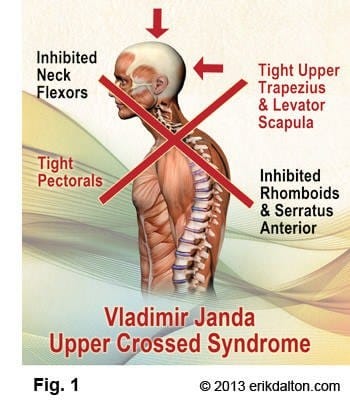What muscles need to be considered if you have upper crossed syndrome?
What is it, and what can you do about it?

Upper crossed syndrome is an imbalance of muscles including tightness and weakness between the front of the chest, neck and upper back. Typically, the way this presents is:
tight pectoralis major and minor(chest muscles)
tight upper trapezius
tight levator scapula(a muscle that connects from the cervical spine in the neck to the top of the shoulder blade)
weak deep neck flexors
weak middle trapezius
weak lower trapezius
People typically have a forward head posture, rounded and elevated shoulders, and increased kyphosis(rounding) of the thoracic spine. And, my clients describe a feeling of stress or tension in their shoulders and neck. It can cause shoulder pain, winging shoulder blades, and lower back pain.
Bringing a balance of tension between the structures that are tight with the structures that are weak is helpful. It can take time to lengthen or re-tension areas that are tight just as it can take time to strengthen muscles that are weak. It’s not always as easy as trying to “sit up straight.” I find that if I sit for a while, then I easily tend to slump and my head does end up in a forward position. What about you? Do you notice this, too, when you’re driving, on an electronic device, or when sitting at your desk?
Here are some things I do that seem to help me tolerate sitting up a bit straighter for longer periods of time without neck or upper back pain. I hope you try them and see how they might feel for you! I’d love to know, so leave a comment if you’d like to share, or if you have any questions!
Maintain the natural curves in your spine with the neck and lower back being lordotic (curving inward) and the thoracic spine curving outward. Find a neutral position in the pelvis by shifting your pelvis forward and back. Round out the lower back and then arch your lower back. Start with a large movement and as you try these motions, make the range smaller and smaller until you find your neutral position where the lower back is neither excessively arched nor excessively rounded.
Photo by Joyce Hankins on Unsplash Working our way upward from the pelvis, let the belly stay soft without your abdominals gripping. To check this, grab your skin around the abdomen and lower rib cage. Is this skin wiggleable? Can you pull it away from muscles underneath and move it? If you can’t, spend some time with practicing skin rolling and releasing the tension of the abdominal muscles.
Moving into the rib cage area, notice your rib cage position. Are the lower ribs flared out at the front? If so, see if you can alter that position by bringing the ribs down in the front which will open or expand into the lower back. Keep the abdominals soft as you bring the ribs down.
Notice how these changes lower in the spine, lower ribs, and pelvis might affect your upper back. Sometimes, making these changes can alter what’s happening in other areas of the body. If you notice that this is not enough to allow for the shoulders to open and for the head to be stacked over the ribs and pelvis, then you may need to do some focused stretches and strengthening.
The pectorals typically need to be stretched. Here’s one way I’ll invite you to try- Lay on your back with a towel roll either placed vertically along the spine or horizontally just under the bottom of the shoulder blades. With your arms in varied positions, try to allow some long holds of 2-5 minutes for connective tissue restructuring. Start with arms down low and palms facing up. Then, try arms out to a “T” shape with palms up. Try arms in a “Y,” palms up. And, arms in a “W,” palms up.
To alleviate tension in the upper trapezius and levator scapula, I like placing tennis balls or massage balls just above my shoulder blades and lay on my back allowing the pressure of the ball to press into my upper back.
To strengthen the deep neck flexors, try this- laying on your back, nod your head. You can start here and practice nodding with the head in a neutral position, then turn the head to the right and nod, and then turn the head to the left and nod. Try this for 30 seconds each position.
To strengthen the middle trapezius and lower trapezius, according to this Study, the best exercises are to lay on your stomach and lift the arms- for the middle trap, bring your arms into a “T” and turn the thumbs up. Squeeze the shoulder blades, then lift the arms. For the lower trap, bring the arms up to a “Y” position, squeeze the shoulder blades, and lift the arms. Start with the weight of the arm and add weights as able. Aim for weight that is sufficient enough for fatigue at 5-8 reps and aim for 2-5 sets with rest breaks in between each set.
It can take a few months of consistent effort 3 times per week to make changes in the muscles, but with consistent effort, you can see and feel changes in your body. Please reach out to your local physical therapist if you need help! These suggestions I’ve described are helpful, but do not substitute for medical advice and care. If you do try them, I hope you find them to be beneficial!
Take good care,
Sharon




